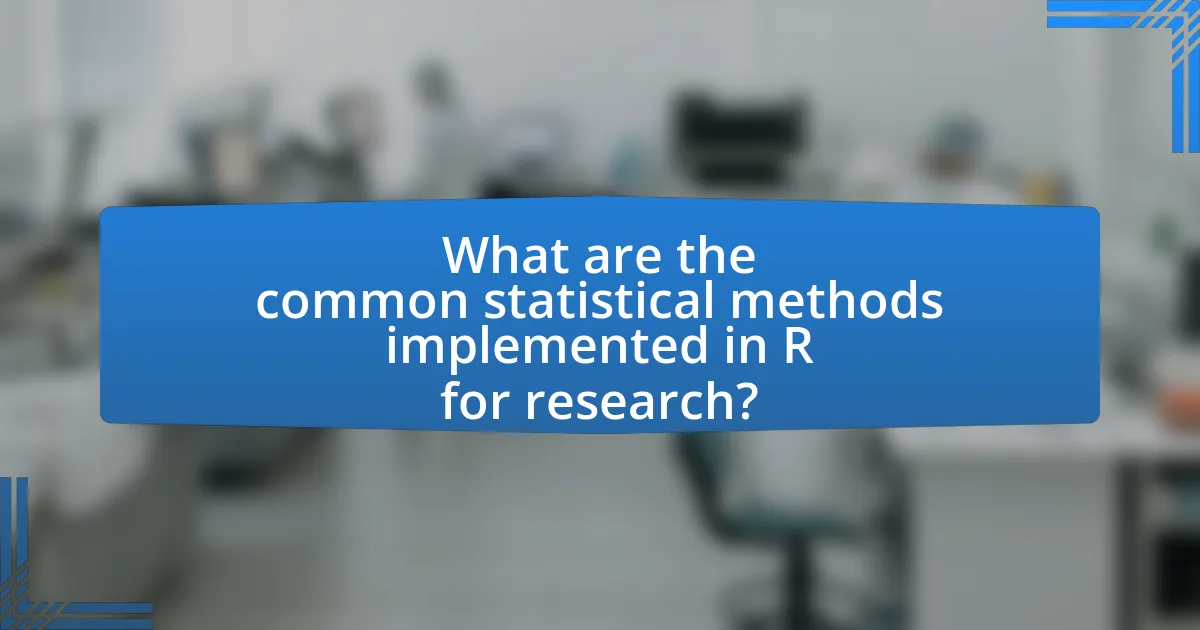R is a programming language and software environment specifically designed for statistical computing and graphics, playing a significant role in scientific research across various fields such as bioinformatics, social sciences, and economics. The article explores R’s extensive statistical capabilities, data visualization tools, and its vast ecosystem of over 18,000 packages available through the Comprehensive R Archive Network (CRAN). Key features of R, including its open-source nature, flexibility, and support for advanced statistical techniques, are discussed, along with comparisons to other statistical software. Additionally, the article highlights essential R packages for data manipulation and visualization, common statistical methods implemented in R, and practical tips for troubleshooting and debugging R code, providing a comprehensive overview of how R enhances statistical computing in scientific research.

What is R and its significance in statistical computing for scientific research?
R is a programming language and software environment specifically designed for statistical computing and graphics. Its significance in scientific research lies in its extensive statistical capabilities, data visualization tools, and a vast ecosystem of packages that facilitate complex data analysis. R is widely used in various fields, including bioinformatics, social sciences, and economics, due to its ability to handle large datasets and perform advanced statistical techniques, such as linear and nonlinear modeling, time-series analysis, and clustering. The Comprehensive R Archive Network (CRAN) hosts over 18,000 packages, providing researchers with a rich resource for specialized analyses, thereby enhancing the reproducibility and transparency of scientific research.
How does R facilitate statistical analysis in scientific studies?
R facilitates statistical analysis in scientific studies by providing a comprehensive environment for data manipulation, statistical modeling, and graphical representation. Its extensive library of packages, such as ggplot2 for visualization and dplyr for data manipulation, allows researchers to perform complex analyses efficiently. Additionally, R supports a wide range of statistical techniques, from basic descriptive statistics to advanced modeling, making it versatile for various scientific disciplines. The open-source nature of R encourages collaboration and sharing of methods, enhancing reproducibility in research. Studies have shown that R is widely adopted in academia and industry, with a significant number of publications utilizing R for statistical analysis, underscoring its effectiveness and reliability in scientific research.
What are the key features of R that support statistical computing?
R is a programming language specifically designed for statistical computing, featuring a comprehensive set of tools for data analysis, visualization, and statistical modeling. Key features include a vast collection of packages, such as ggplot2 for data visualization and dplyr for data manipulation, which enhance its functionality. R also supports a wide range of statistical techniques, from basic descriptive statistics to advanced modeling methods like linear and nonlinear modeling, time-series analysis, and clustering. Furthermore, R’s ability to handle large datasets and perform complex calculations efficiently makes it a preferred choice among statisticians and data scientists. The language’s open-source nature allows for continuous updates and contributions from a global community, ensuring that it remains at the forefront of statistical computing advancements.
How does R compare to other statistical software in research?
R is often considered superior to other statistical software in research due to its extensive package ecosystem, flexibility, and strong community support. Unlike proprietary software such as SPSS or SAS, R is open-source, allowing researchers to access a vast array of statistical techniques and methodologies without licensing fees. Additionally, R’s ability to handle complex data types and perform advanced analyses, such as machine learning and data visualization, is enhanced by packages like ggplot2 and dplyr. According to a study published in the Journal of Statistical Software, R outperforms other software in terms of the breadth of statistical methods available and the ease of integrating with other programming languages, making it a preferred choice for many researchers in various fields.
Why is R preferred by researchers in various scientific fields?
R is preferred by researchers in various scientific fields due to its powerful statistical capabilities and extensive package ecosystem. The language is specifically designed for data analysis and visualization, making it highly effective for complex statistical computations. R offers a wide range of packages, such as ggplot2 for data visualization and dplyr for data manipulation, which enhance its functionality. Additionally, R’s open-source nature allows for continuous development and community support, ensuring that researchers have access to the latest tools and methodologies. Studies have shown that R is widely adopted in academia, with a significant presence in fields such as bioinformatics, social sciences, and econometrics, further validating its preference among researchers.
What advantages does R offer for data visualization in research?
R offers several advantages for data visualization in research, including a wide range of packages, flexibility, and high-quality graphics. The extensive collection of packages, such as ggplot2 and lattice, allows researchers to create complex visualizations tailored to their specific data needs. R’s flexibility enables users to customize plots extensively, adjusting elements like colors, themes, and labels to enhance clarity and presentation. Additionally, R produces high-quality graphics suitable for publication, ensuring that visual representations meet professional standards. These features collectively make R a powerful tool for researchers aiming to effectively communicate their findings through data visualization.
How does R’s open-source nature benefit scientific research?
R’s open-source nature significantly benefits scientific research by providing free access to a vast array of statistical tools and packages. This accessibility allows researchers from diverse backgrounds to utilize advanced analytical methods without financial barriers, fostering collaboration and innovation. For instance, the Comprehensive R Archive Network (CRAN) hosts over 18,000 packages, enabling researchers to share and build upon each other’s work, which accelerates the pace of scientific discovery. Additionally, the open-source model encourages transparency and reproducibility in research, as others can verify and replicate findings using the same code and data. This has been shown to enhance the credibility of scientific results, as highlighted in studies emphasizing the importance of reproducibility in research practices.

What are the essential packages in R for statistical computing?
The essential packages in R for statistical computing include ‘stats’, ‘ggplot2’, ‘dplyr’, ‘tidyr’, and ‘lme4’. The ‘stats’ package is built into R and provides a wide range of statistical functions, making it foundational for statistical analysis. ‘ggplot2’ is widely used for data visualization, allowing users to create complex graphics easily. ‘dplyr’ offers a set of tools for data manipulation, enabling efficient data transformation and summarization. ‘tidyr’ complements ‘dplyr’ by helping to tidy data, ensuring it is in a suitable format for analysis. ‘lme4’ is essential for fitting linear and generalized linear mixed-effects models, which are crucial in many scientific research contexts. These packages are widely recognized and utilized in the R community, underscoring their importance in statistical computing.
Which R packages are most commonly used in scientific research?
The most commonly used R packages in scientific research include ggplot2, dplyr, tidyr, and caret. ggplot2 is widely recognized for data visualization, allowing researchers to create complex graphics easily. dplyr is essential for data manipulation, providing a set of functions that streamline data transformation tasks. tidyr complements dplyr by helping to tidy data, making it easier to work with. caret is frequently utilized for machine learning, offering tools for model training and evaluation. These packages are supported by extensive documentation and community usage, confirming their prevalence in the scientific research community.
How do packages like ggplot2 enhance data visualization?
Packages like ggplot2 enhance data visualization by providing a powerful and flexible framework for creating complex graphics based on the Grammar of Graphics. This approach allows users to build visualizations layer by layer, facilitating the customization of plots to convey specific insights effectively. For instance, ggplot2 supports a wide range of plot types, including scatter plots, bar charts, and histograms, enabling researchers to choose the most appropriate visualization for their data. Additionally, ggplot2 integrates seamlessly with R’s data manipulation packages, such as dplyr, allowing for efficient data preprocessing before visualization. This integration enhances the overall workflow in statistical computing, making it easier for scientists to present their findings clearly and effectively.
What role do packages like dplyr and tidyr play in data manipulation?
Packages like dplyr and tidyr are essential tools for data manipulation in R, providing streamlined functions for data transformation and cleaning. dplyr focuses on data frame manipulation, offering functions such as filter, select, mutate, and summarize, which enable users to efficiently manipulate and analyze datasets. Tidyr complements dplyr by providing functions like gather and spread, which facilitate reshaping data into tidy formats, making it easier to work with in analyses. The integration of these packages enhances productivity and clarity in data workflows, as evidenced by their widespread adoption in the R community for tasks ranging from exploratory data analysis to complex statistical modeling.
How can researchers effectively utilize R packages for their studies?
Researchers can effectively utilize R packages for their studies by selecting appropriate packages that align with their specific analytical needs and ensuring they understand the underlying functions and methodologies. For instance, the ‘ggplot2’ package is widely used for data visualization, allowing researchers to create complex graphics easily, while ‘dplyr’ facilitates data manipulation through a clear syntax. Familiarity with the Comprehensive R Archive Network (CRAN) and resources like R documentation and vignettes enhances researchers’ ability to implement these packages effectively. Studies have shown that utilizing R packages can significantly streamline data analysis processes, improve reproducibility, and enhance the clarity of results, as evidenced by the increasing adoption of R in various scientific fields.
What are best practices for installing and managing R packages?
Best practices for installing and managing R packages include using the install.packages() function for installation, regularly updating packages with update.packages(), and utilizing the renv package for project-specific environments. The install.packages() function allows users to easily install packages from CRAN, ensuring access to the latest versions. Regular updates with update.packages() help maintain compatibility and security, as outdated packages can lead to errors or vulnerabilities. The renv package facilitates the creation of isolated environments, which prevents conflicts between package versions across different projects, thereby enhancing reproducibility in scientific research. These practices are supported by the R community’s emphasis on reproducibility and package management, as outlined in the R for Data Science book by Hadley Wickham and Garrett Grolemund.
How can researchers find and integrate new packages into their workflow?
Researchers can find and integrate new packages into their workflow by utilizing the Comprehensive R Archive Network (CRAN) and GitHub. CRAN provides a centralized repository where researchers can search for packages based on functionality, popularity, and user reviews, ensuring they select the most relevant tools for their statistical needs. GitHub serves as a platform for discovering cutting-edge packages that may not yet be available on CRAN, allowing researchers to access the latest developments in R programming.
To integrate these packages, researchers can use the R command install.packages("package_name") for CRAN packages or devtools::install_github("username/repo") for GitHub packages. This straightforward installation process enables seamless incorporation of new tools into existing workflows. The effectiveness of this approach is supported by the fact that CRAN hosts over 18,000 packages, providing a vast array of options for various statistical analyses, thereby enhancing the research capabilities of scientists using R.

What are the common statistical methods implemented in R for research?
Common statistical methods implemented in R for research include linear regression, logistic regression, ANOVA, t-tests, chi-squared tests, and time series analysis. Linear regression is widely used for modeling relationships between variables, while logistic regression is essential for binary outcome predictions. ANOVA helps in comparing means across multiple groups, and t-tests are utilized for comparing means between two groups. Chi-squared tests assess the association between categorical variables, and time series analysis is crucial for analyzing data points collected or recorded at specific time intervals. These methods are supported by R’s extensive libraries and packages, such as ‘stats’ and ‘lmtest’, which facilitate their application in various research contexts.
How can R be used for hypothesis testing in scientific research?
R can be used for hypothesis testing in scientific research by providing a comprehensive suite of statistical functions and packages that facilitate the analysis of data. Researchers can perform various tests, such as t-tests, ANOVA, and chi-squared tests, using built-in functions like t.test(), aov(), and chisq.test(), respectively. These functions allow for the calculation of p-values, confidence intervals, and effect sizes, which are essential for determining the statistical significance of results. Additionally, R’s graphical capabilities enable researchers to visualize data distributions and test assumptions, enhancing the interpretability of hypothesis tests. The extensive documentation and community support for R further validate its effectiveness in conducting rigorous statistical analyses in scientific research.
What statistical tests can be performed using R?
R can perform a wide range of statistical tests, including t-tests, ANOVA, chi-squared tests, linear regression, logistic regression, and non-parametric tests such as the Mann-Whitney U test and Kruskal-Wallis test. These tests are implemented through various packages in R, such as ‘stats’ for basic statistical functions and ‘car’ for advanced regression analysis. The versatility of R allows researchers to apply these tests to analyze data effectively, making it a powerful tool in scientific research.
How does R handle assumptions of statistical tests?
R handles assumptions of statistical tests by providing diagnostic tools and functions that allow users to check these assumptions before conducting tests. For instance, R includes functions like shapiro.test() for normality, bartlett.test() for homogeneity of variances, and plot() for visual diagnostics such as Q-Q plots and residual plots. These tools enable researchers to validate the assumptions underlying various statistical tests, ensuring the integrity of their analyses. The comprehensive documentation and community support further enhance R’s capability to address assumption checks effectively, making it a robust choice for statistical computing in scientific research.
What role does R play in data modeling and machine learning?
R serves a crucial role in data modeling and machine learning by providing a comprehensive environment for statistical analysis and visualization. Its extensive libraries, such as caret and randomForest, facilitate the implementation of various machine learning algorithms, enabling users to build predictive models efficiently. Additionally, R’s strong graphical capabilities allow for effective data visualization, which is essential for understanding complex datasets and model performance. The language’s integration with data manipulation packages like dplyr enhances its utility in preprocessing data, a critical step in the modeling process. These features collectively make R a preferred choice among researchers and data scientists for conducting rigorous statistical analyses and developing machine learning applications.
How can researchers build predictive models using R?
Researchers can build predictive models using R by utilizing various packages and functions designed for statistical analysis and machine learning. The process typically involves data preparation, model selection, training, and evaluation. For instance, researchers can use the ‘caret’ package for streamlined model training and evaluation, while the ‘glm’ function allows for fitting generalized linear models. Additionally, the ‘randomForest’ package can be employed for building ensemble models. According to a study published in the Journal of Statistical Software, R’s extensive libraries and community support facilitate the development of robust predictive models, making it a preferred choice among statisticians and data scientists.
What machine learning algorithms are available in R?
R offers a wide range of machine learning algorithms, including linear regression, logistic regression, decision trees, random forests, support vector machines, k-nearest neighbors, neural networks, and gradient boosting machines. These algorithms are implemented in various R packages such as caret, randomForest, e1071, nnet, and xgboost, which facilitate their application in statistical computing and scientific research. The versatility of R in handling different types of data and its extensive libraries make it a powerful tool for machine learning tasks.
What are some practical tips for troubleshooting R in scientific research?
To troubleshoot R in scientific research effectively, start by checking for syntax errors, as they are common and can halt execution. Ensure that all packages are correctly installed and loaded, as missing libraries can lead to function errors. Utilize the built-in help system by accessing documentation with the help() function or searching for specific functions online to clarify usage. Debugging tools like browser() and debug() can help identify where code fails. Additionally, reviewing error messages carefully provides insights into what went wrong, allowing for targeted fixes. Finally, seeking assistance from community forums such as Stack Overflow can provide solutions from experienced users who may have encountered similar issues.
How can researchers effectively debug their R code?
Researchers can effectively debug their R code by utilizing built-in debugging tools such as the debug(), traceback(), and browser() functions. These functions allow researchers to step through their code, inspect variable values, and identify where errors occur. For instance, the debug() function enables line-by-line execution of a function, making it easier to pinpoint the source of an error. Additionally, using traceback() after an error occurs provides a stack trace that shows the sequence of function calls leading to the error, which is crucial for understanding the context of the problem. Furthermore, employing the options(error = recover) setting allows researchers to enter a debugging environment when an error occurs, facilitating immediate inspection of the workspace. These methods are widely recognized in the R community for their effectiveness in identifying and resolving coding issues.
What resources are available for learning R and improving statistical skills?
Comprehensive resources for learning R and enhancing statistical skills include online platforms, textbooks, and community forums. Websites like Coursera and edX offer structured courses on R programming and statistics, often created by reputable universities. Textbooks such as “R for Data Science” by Hadley Wickham provide practical insights into using R for data analysis. Additionally, the R community on platforms like Stack Overflow and R-bloggers offers valuable support and shared knowledge, facilitating peer learning and problem-solving. These resources collectively support both beginners and advanced users in mastering R and statistical concepts.


